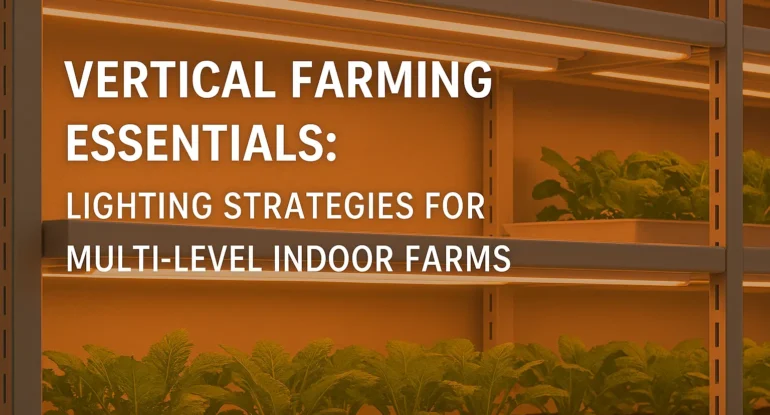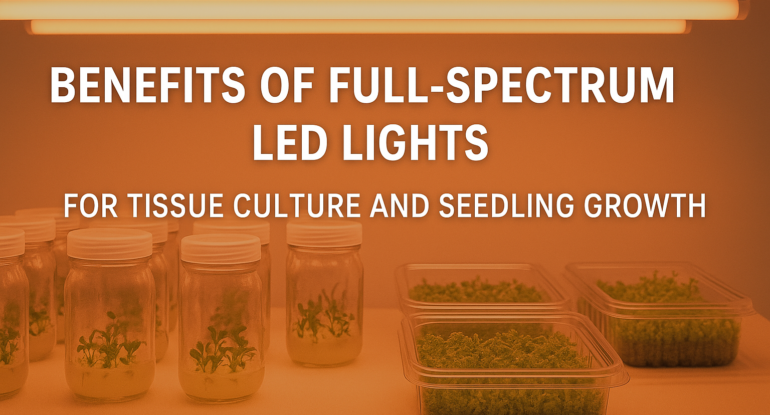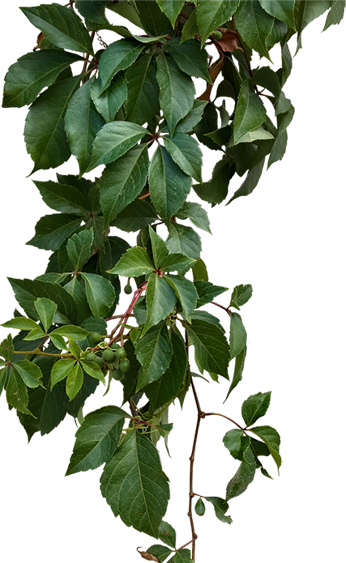
09
May
Vertical Farming Essentials: Lighting Strategies for Multi-Level Indoor Farms
As cities like Auckland, Wellington, and Christchurch grow rapidly, New Zealand faces a pressing challenge: how to produce fresh, local food sustainably within urban limits. Vertical farming is emerging as a transformative solution — using multi-tier indoor systems to grow crops efficiently in warehouses, greenhouses, and even converted shipping containers. One of the most critical components of successful vertical farming in NZ is lighting. Without sunlight, indoor crops rely entirely on artificial light, and the quality, intensity, and duration of that light can make or break your yield. In this guide, we’ll explore lighting strategies tailored for vertical farming in New Zealand, with a focus on LED grow lights, energy efficiency, and plant-specific optimization. 🌱 Why Vertical Farming is Growing in New Zealand Vertical farming offers unique advantages for New Zealand growers: Year-round growing: Perfect for regions with harsh winters or unstable outdoor conditions. Urban food security: Reduces transport costs and ensures fresher produce. Sustainable agriculture: Uses 90% less water and no soil, reducing the need for pesticides. Scalable for small businesses: Perfect for Māori growers, startups, and small-scale operators. But to unlock these benefits, effective lighting strategies are key. 🔆 Understanding the Role of Lighting in Vertical Farms Unlike traditional greenhouses or outdoor farms, vertical farming systems are typically enclosed environments. That means all the light needed for photosynthesis must be provided artificially — and it has to be the right kind of light. LED grow lights are now the industry standard due to their: Energy efficiency (lower power bills) Longevity (50,000+ hours of use) Customizability (specific spectrum control) In a multi-tier system, where plants are stacked in shelves, uniform light distribution and heat control become especially important. 💡 Top Lighting Strategies for Vertical Farming in NZ 1. Full-Spectrum LED Grow Lights Plants need different wavelengths for different stages of growth: Blue light (400–500 nm): Stimulates strong vegetative growth (ideal for leafy greens). Red light (600–700 nm): Encourages flowering and fruiting (tomatoes, capsicum). Far-red and UV: Enhance pigmentation, flavor, and secondary metabolites. In New Zealand, full-spectrum LED bars or panels allow growers to mimic natural sunlight and tailor output depending on crop and season. 2. PPFD Optimization (Photosynthetic Photon Flux Density) Rather than just wattage, focus on PPFD — the amount of usable light reaching your plants (measured in µmol/m²/s). For vertical farming: Leafy greens: 100–250 PPFD Fruiting vegetables: 300–600 PPFD Tissue culture: 40–80 PPFD LED lights should be mounted close to plants (20–40cm) and adjusted based on growth stage. 3. Photoperiod Scheduling with Timers Plants need rest, too. Use digital timers or automation tools to set day/night cycles: Leafy greens: 14–16 hours of light Tomatoes, capsicum: 12–14 hours Microgreens: 8–10 hours (short lifecycle) Photoperiod control is crucial to reduce stress, improve yield, and minimize energy waste. 4. Layered Light Placement for Multi-Tier Racks In vertical farms, light must reach each layer equally. Poor lighting on the lower levels leads to poor yields. ✅ Use narrow-angle lenses or adjustable LED bars on each layer ✅ Ensure reflectivity on rack walls to minimize loss ✅ Avoid heat buildup using low-heat LEDs or water-cooled systems 5. Integrating Sensors and IoT for Smart Farming IoT sensors (light, temperature, humidity) allow real-time data collection. With smart lighting controllers, NZ growers can: Auto-adjust spectrum and intensity Monitor crop performance remotely Reduce labour costs and human error This is particularly beneficial for remote farms or large-scale indoor facilities in areas like Tauranga or Invercargill. 🇳🇿 Real-Life Use Case in New Zealand A vertical farming startup in Wellington installed a 5-tier leafy green farm using full-spectrum LED bars. By optimizing blue-red ratios and using smart scheduling, they reduced energy consumption by 40% while achieving 35% faster harvests than traditional greenhouse methods. Their crops now supply cafes and home delivery boxes across the region. ✅ Advantages of Optimized LED Lighting in Vertical Farms 🔋 Lower energy bills with efficient power use 🌿 Faster plant growth with ideal spectrum targeting 🌡️ Cooler temperatures, reducing HVAC load 🌎 Eco-friendly operation, supporting NZ’s carbon goals 💧 Better water retention, thanks to less evaporation from heat 🌏 Supporting Local AgTech Growth in NZ LED lighting in vertical farming supports: Urban food systems in Auckland and Christchurch Māori-led farming collectives using sustainable methods Horticulture education in NZ schools and universities Indoor gardening trends among hobby growers FAQs 1. What type of LED grow light is best for vertical farming in New Zealand? Answer: Full-spectrum LED grow lights are the best choice for vertical farming in New Zealand. They mimic natural sunlight and provide the ideal range of light wavelengths (including red, blue, and far-red) needed for different stages of plant growth. Look for energy-efficient models with adjustable spectrum and high PPFD ratings for maximum crop yield. 2. How much light do plants need in a multi-tier indoor farm? Answer: Light requirements vary by crop, but most leafy greens thrive with 100–250 PPFD, while fruiting crops like tomatoes may need 300–600 PPFD. In a vertical farm setup, it’s important to ensure even distribution across all layers and adjust intensity based on plant height and stage of growth. 3. Can vertical farming with LEDs reduce power costs in New Zealand? Answer: Yes. LED grow lights consume significantly less electricity than older technologies like HPS or fluorescent lights. When combined with timers and smart sensors, they help NZ growers cut energy costs, reduce carbon footprints, and qualify for sustainability incentives. 4. Is vertical farming suitable for small-scale growers or hobbyists in NZ? Answer: Absolutely. Vertical farming systems can be scaled to suit homes, garages, and small commercial setups. With modular racks and compact LED lights, even hobbyists in urban NZ areas can grow fresh greens, herbs, or microgreens indoors year-round. 5. What are the main challenges of lighting in vertical farms? Answer: The main challenges include ensuring uniform light across tiers, managing heat (especially in enclosed spaces), optimizing spectrum for different crops, and keeping energy usage efficient. Fortunately, modern LED solutions and smart automation systems are addressing these issues effectively.

07
May
Benefits of Full-Spectrum LED Lights for Tissue Culture and Seedling Growth
The advancement of full-spectrum LED grow lights has revolutionized modern agriculture—especially for delicate processes like tissue culture and seedling development. In New Zealand, where growers, horticulturists, and research labs aim for high yield, energy efficiency, and plant uniformity, full-spectrum lighting has become an essential part of the cultivation strategy. This comprehensive guide explores the top benefits of full-spectrum LED grow lights for tissue culture and seedling growth, including light science, application strategies, energy savings, and commercial impact. What Are Full-Spectrum LED Grow Lights? Full-spectrum LED grow lights mimic natural sunlight, offering a broad range of wavelengths from ultraviolet (UV) to infrared (IR). These lights typically include: Blue Light (400–500 nm): Encourages vegetative growth and compact plant structure. Red Light (600–700 nm): Essential for root formation, flowering, and fruiting. Green Light (500–600 nm): Enhances canopy penetration. Far-Red Light (700–750 nm): Influences flowering cycles and plant elongation. UV Light (100–400 nm): Stimulates secondary metabolite production and stress tolerance. Full-spectrum lighting provides a balanced wavelength distribution, making it suitable for all plant growth stages—from explant initiation to transplant-ready seedlings. Why Full-Spectrum LEDs Are Essential in Tissue Culture Tissue culture, or micropropagation, is the process of growing plants in sterile, nutrient-rich media under controlled conditions. Lighting plays a critical role in: Callus initiation Shoot proliferation Root induction Hardening stages Key Benefits for Tissue Culture: 1. Balanced Growth with Blue and Red Light In tissue culture, explants require a fine balance of blue and red wavelengths. Full-spectrum LEDs deliver optimal ratios that: Stimulate chlorophyll synthesis Enhance photosynthetic efficiency Promote balanced root and shoot growth This is especially useful for propagating plants like bananas, orchids, strawberries, and medicinal herbs in New Zealand tissue culture labs. 2. Uniform Light Distribution Across Culture Shelves Full-spectrum LED light bars and panels are engineered to offer uniform PAR (Photosynthetically Active Radiation) across growing surfaces. This leads to: Consistent explant growth across trays Reduced photoinhibition and light stress Fewer morphological abnormalities In vertical farming racks, uniformity ensures high throughput and better yield per shelf. 3. Reduced Heat Output and Risk of Contamination Unlike traditional HPS or fluorescent lighting, full-spectrum LED lights produce minimal heat, making them ideal for sealed and sterile environments. Less heat means: Reduced contamination risks Lower cooling costs Safer handling near sensitive cultures For growers in warmer regions of NZ or in climate-controlled greenhouses, this translates to energy savings and improved lab safety. 4. Customizable Spectral Output for Research and Precision Growing Many advanced full-spectrum LEDs used in New Zealand now offer programmable spectrums, allowing labs and growers to tailor wavelengths to: Specific plant genotypes Culture stages (callus, shoot, root) Regional climate factors This is highly advantageous in plant biotechnology and academic research facilities where optimization is crucial. Benefits of Full-Spectrum LEDs for Seedling Growth Once tissue culture plants are acclimatized or when seeds germinate in nurseries, seedling growth requires different light management. Full-spectrum LEDs provide benefits such as: 5. Faster Germination and Stronger Seedlings The blue and red portions of the spectrum stimulate rapid germination, improved cell division, and sturdy stem formation. This results in: Healthier, pest-resistant seedlings Uniform canopy height Faster transplanting cycles Growers of vegetables, ornamentals, and fruit trees in NZ benefit from quicker production and higher propagation success. 6. Better Morphology and Compact Growth New Zealand’s indoor growers and hobbyists often face leggy or stretched seedlings when using poor lighting. Full-spectrum LEDs help produce: Compact, short-internode seedlings Better root-to-shoot ratio Higher survival rate during transplantation This is vital in vertical farming, greenhouses, or limited-space growing rooms. 7. Improved Nutrient Absorption and Photosynthesis Full-spectrum lighting improves the uptake of water and nutrients, thanks to higher photosynthetic rates. Resulting seedlings are: More resilient to transplant shock Quicker to enter vegetative stages More efficient in water use This helps optimize fertilizer costs and improves ROI for both commercial and small-scale growers. New Zealand Case Study: A Rotorua Seedling Nursery A commercial nursery in Rotorua replaced old metal halide lamps with programmable full-spectrum LEDs across their seedling trays. The results: 32% faster germination of lettuce and tomato seedlings 22% increase in uniformity rate 47% savings on monthly electricity costs 15% higher transplant survival These LEDs were tuned to deliver 160 µmol/m²/s PPFD, with a 16-hour photoperiod, ideal for early growth. Environmental and Economic Benefits for NZ Growers Switching to full-spectrum LED lights offers long-term advantages in the New Zealand growing climate: ✅ Energy Savings: Up to 60% less power use compared to fluorescent or HID lamps ✅ Lower Carbon Footprint: Ideal for eco-conscious and organic farms ✅ Reduced Maintenance: 50,000+ hour lifespan with minimal degradation ✅ Government Grants: Eligibility under some NZ sustainability programs For indoor growers, tissue culture labs, and vertical farms, this lighting solution reduces both operational costs and environmental impact. How to Choose the Right Full-Spectrum LED for Your Setup Whether you’re managing a commercial tissue culture lab or a small seedling nursery, consider: Feature Importance Adjustable Spectrum Tailors to crop types and stages Dimmable Output Controls intensity for delicate growth Uniform Coverage Crucial for multi-shelf or multi-tray setups IP Rating Ensures protection from humidity Certifications Look for CE, RoHS, or NZ-compliant marks Conclusion Full-spectrum LED lights offer unmatched versatility and efficiency for tissue culture and seedling production. For growers across New Zealand, from biotech labs to indoor hobbyists, these lights deliver: Faster, uniform plant growth Reduced power consumption Precise spectrum control Minimal heat and contamination risks As sustainable agriculture gains momentum in New Zealand, integrating full-spectrum LED lighting into your micropropagation or nursery setup is a step toward profitable, eco-friendly cultivation. Frequently Asked Questions (FAQs) 1. What is a full-spectrum LED grow light? Answer: A full-spectrum LED grow light emits a balanced range of wavelengths—mimicking natural sunlight—including blue, red, green, far-red, and sometimes ultraviolet (UV). It supports all stages of plant growth, from tissue culture to flowering and fruiting, making it ideal for indoor and greenhouse farming in New Zealand. 2. Are full-spectrum LEDs better than regular grow lights? Answer: Yes. Full-spectrum LEDs provide more tailored wavelengths for photosynthesis and plant development. Compared



